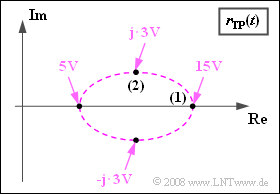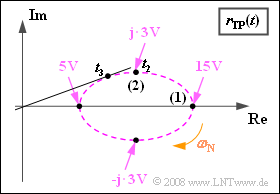A cosine-shaped source signal $q(t)$ with amplitude $A_{\rm N}$ and frequency $f_{\rm N}$ is double-sideband amplitude modulated. The modulated signal is given by:
- $$ s(t) = \big[ q(t) + A_{\rm T}\big] \cdot \cos(2 \pi \cdot f_{\rm T} \cdot t ) \hspace{0.05cm}.$$
The transmission channel exhibits linear distortions:
- While the lower sideband $($LSB frequency: $f_{\rm T} - f_{\rm N})$ and the carrier are transmitted undistorted,
- the upper sideband $($USB frequency: $f_{\rm T} + f_{\rm N})$ is weighted with the attenuation factor $α_{\rm O} = 0.25$.
The graph shows the locus curve, i.e., the representation of the equivalent low-pass signal $r_{\rm TP}(t)$ in the complex plane.
Evaluating the signal $r(t)$ with an ideal envelope demodulator, we obtain a sink signal $v(t)$, which can be approximated as follows:
- $$v(t) = 2.424 \,{\rm V} \cdot \cos(\omega_{\rm N} \cdot t ) -0.148 \,{\rm V} \cdot \cos(2\omega_{\rm N} \cdot t )+ 0.056 \,{\rm V} \cdot \cos(3\omega_{\rm N} \cdot t )-\text{ ...}$$
For this measurement, the message frequency $f_{\rm N} = 2 \ \rm kHz$ was used.
In subtask (7) the signal-to-noise power ratio $\rm (SNR)$ should be calculated as follows:
- $$ \rho_{v } = P_{v 1}/P_{\varepsilon } \hspace{0.05cm}.$$
Here, $P_{v1} = α^2 · P_q$ and $P_ε$ denote the "powers" of both signals:
- $$ v_1(t) = 2.424 \,{\rm V} \cdot \cos(\omega_{\rm N} \cdot t )\hspace{0.05cm},$$
- $$ \varepsilon(t) = v(t) - v_1(t) \approx -0.148 \,{\rm V} \cdot \cos(2\omega_{\rm N} \cdot t )+ 0.056 \,{\rm V} \cdot \cos(3\omega_{\rm N} \cdot t ) \hspace{0.05cm}.$$
Hints:
- This exercise belongs to the chapter Envelope Demodulation.
- Particular reference is made to the section Description using the equivalent low-pass signal.
Questions
Solution
- $$ r_{\rm TP}(t) = A_{\rm T} + \frac{A_{\rm N}}{2} \cdot \alpha_{\rm O} \cdot{\rm e}^{{\rm j} \cdot \hspace{0.03cm}\omega_{\rm N}\cdot t} + \frac{A_{\rm N}}{2} \cdot{\rm e}^{-{\rm j} \cdot \hspace{0.03cm}\omega_{\rm N}\cdot t}\hspace{0.05cm}.$$
- At time $t = 0$ all vectors point in the direction of the real axis.
- Thus $r_{\rm TP}(t = 0)\hspace{0.15cm}\underline { = 15 \ \rm V}$ can be read from the graph on the exercise page.
(2) The carrier amplitude is defined by the center of the ellipse:
$A_{\rm T}\hspace{0.15cm}\underline { = 10 \ \rm V}$.
- From the equation given in the first subtask, the amplitude $A_{\rm N}$ can thus also be calculated:
- $$ \frac{A_{\rm N}}{2} \cdot ( 1+ \alpha_0) = r_{\rm TP}(t= 0) - A_{\rm T} = 5 \,{\rm V}\hspace{0.3cm} \Rightarrow \hspace{0.3cm}A_{\rm N} \hspace{0.15cm}\underline {= 8 \,{\rm V}} \hspace{0.05cm}.$$
- The point marked (2) can be used as a check:
- $$\frac{A_{\rm N}}{2} \cdot ( 1- \alpha_0) = 3 \,{\rm V}\hspace{0.3cm} \Rightarrow \hspace{0.3cm}A_{\rm N} = 8 \,{\rm V} \hspace{0.05cm}.$$
(3) The necessary time for one cycle $t_1$ is equal to the time period of the source signal:
- $$t_1= 1/f_{\rm N} \hspace{0.15cm}\underline {=0.5 \ \rm ms}.$$
(4) Since the lower sideband is larger than the upper sideband, the peak of the pointer composite moves clockwise around the ellipse.
- Point (2) is first reached at time $t_2 = 3/4 · t_1\hspace{0.15cm}\underline { = 0.375 \ \rm ms}$.
(5) The pointer length at time $t_2$ can be determined with the Pythagorean Theorem :
- $$ a(t = t_2) = \sqrt{(10 \,{\rm V})^2 + (3 \,{\rm V})^2}\hspace{0.15cm}\underline { = 10.44 \,{\rm V}}\hspace{0.05cm}.$$
- The phase function is:
- $$\phi(t = t_2) = {\rm arctan} \frac{3 \,{\rm V}}{10 \,{\rm V}} \hspace{0.15cm}\underline {= 16.7^{\circ}}\hspace{0.05cm}.$$
- The maximum phase $ϕ_{\rm max}$ is slightly larger.
- It occurs (with a positive sign) at time $t_3 < t_2$ when a straight line from the origin is tangent to the ellipse.
- By setting up the ellipse equation, this point $(x_3$, $y_3)$ can be accurately calculated analytically.
- From this, the following would hold for the maximum phase:
- $$\phi_{\rm max} = {\rm arctan} \ {y_3}/{x_3} \hspace{0.05cm}.$$
(6) The distortion factors of second and third order can be obtained from the equation given for $v(t)$ $($valid for $f_{\rm N} = 2 \ \rm kHz)$:
- $$ K_2 = \frac{0.148 \,{\rm V}}{2.424 \,{\rm V}} = 0.061, \hspace{0.3cm} K_3 = \frac{0.056 \,{\rm V}}{2.424 \,{\rm V}} = 0.023 \hspace{0.05cm}.$$
- Thus, for the total distortion factor we get:
- $$K = \sqrt{K_2^2 + K_3^2 }\hspace{0.15cm}\underline { \approx 6.6 \%}.$$
(7) From the power of the useful signal and the interference signal, we obtain:
- $$ P_{v 1} = \frac{(2.424 \,{\rm V})^2}{2} = 2.94 \,{\rm V}^2\hspace{0.05cm},\hspace{0.3cm} P_{\varepsilon} = \frac{(-0.148 \,{\rm V})^2}{2} + \frac{(0.056 \,{\rm V})^2}{2}= 0.0125 \,{\rm V}^2\hspace{0.05cm}$$
- This gives the signal-to-noise power ratio $\rm (SNR)$:
- $$\rho_{v} = \frac{P_{v 1}}{P_{\varepsilon }}= \frac{(2.94 \,{\rm V})^2}{0.0125 \,{\rm V}^2} \hspace{0.15cm}\underline {\approx 230} = \frac{1}{K^2} \hspace{0.05cm}.$$
- If, on the other hand, the amplitude distortion were also assigned to the error signal, we would arrive at a much smaller $\rm SNR$.
- When $P_q = A_{\rm N}^2/2 = 8 \ \rm V^2$ and $P_{\varepsilon}\hspace{0.02cm}' = \overline{(v(t)-q(t))^2} = {1}/{2}\cdot ( 4 \,{\rm V} - 2.424 \,{\rm V})^2 + P_{\varepsilon}= 1.254 \,{\rm V}^2$ one would get:
- $$\rho_{v }\hspace{0.02cm}' = \frac{8 \,{\rm V}^2}{1.254 \,{\rm V}^2} \approx 6.4\hspace{0.05cm}.$$
(8) All calculations are valid regardless of the message frequency $f_{\rm N}$ if the attenuation factor of the upper sideband remains at $α_{\rm O} = 0.25$ .
- Thus, the same distortion factor $K\hspace{0.15cm}\underline { \approx 6.6 \%}$ is obtained even for $f_{\rm N} = 4 \ \rm kHz$ .

